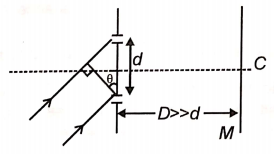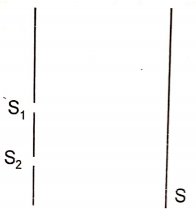A diffraction pattern is obtained using a beam of blue light. What happens if the blue light is replaced by red light?
1. No change
2. Diffraction bands become narrower and crowded together
3. Bands become broader and farther apart
4. Bands disappear

To unlock all the explanations of 14 chapters you need to be enrolled in MasterClass Course.

To unlock all the explanations of 14 chapters you need to be enrolled in MasterClass Course.
In YDSE, when a thin transparent sheet of thickness t and refractive index = 1.5 is placed just in front of the upper slit, the central bright fringe shifts to the nth bright fringe. Then n is [ wavelength of light in the air]
1.
2.
3.
4.

To unlock all the explanations of 14 chapters you need to be enrolled in MasterClass Course.

To unlock all the explanations of 14 chapters you need to be enrolled in MasterClass Course.
In YDSE, refer to figure, d >> and . The central bright fringe is obtained at distance x above Point C, then x is:

1.
2.
3. 2D
4. Zero

To unlock all the explanations of 14 chapters you need to be enrolled in MasterClass Course.

To unlock all the explanations of 14 chapters you need to be enrolled in MasterClass Course.
A parallel beam of white light falls on the plane of slits separated by a distance d. The distance above O, at which there will be bright fringe will be:

1.
2.
3.
4.

To unlock all the explanations of 14 chapters you need to be enrolled in MasterClass Course.

To unlock all the explanations of 14 chapters you need to be enrolled in MasterClass Course.
White light is used for double-slit interference, for how many wavelengths, we get maximum at point P shown here on the screen?

1. 1
2. 2
3. 3
4. 7

To unlock all the explanations of 14 chapters you need to be enrolled in MasterClass Course.

To unlock all the explanations of 14 chapters you need to be enrolled in MasterClass Course.
The figure here shows \(P\) and \(Q\) as two equally intense coherent sources emitting radiations of wavelength \(20~\text{m}\). The separation \(PQ\) is \(5.0~\text{m}\) and the phase of \(P\) is ahead of the phase of \(Q\) by \(90^{\circ}.\)\(A, B,\) and \(C\) are three distant points of observation equidistant from the midpoint of \(PQ\). The intensity of radiations at \(A,B,C\) will bear the ratio:

1. \(0:1:4\)
2. \(4:1:0\)
3. \(0:1:2\)
4. \(2:1:0\)

To unlock all the explanations of 14 chapters you need to be enrolled in MasterClass Course.

To unlock all the explanations of 14 chapters you need to be enrolled in MasterClass Course.
In Young's double-slit experiment the intensity of light on screen due to each slit is Interference pattern is observed along a direction parallel to the line , on-screen S

The minimum, maximum, and the intensity averaged over the entire screen are respectively:
1. 0, 4, 2
2. 0, 4,
3. , 2, 3/2
4. 0, ,

To unlock all the explanations of 14 chapters you need to be enrolled in MasterClass Course.

To unlock all the explanations of 14 chapters you need to be enrolled in MasterClass Course.
An unpolarized beam of light of intensity passes through two linear polarizers making an
angle of 30 with respect to each other. The emergent beam will have an intensity:
1.
2.
3.
4.

To unlock all the explanations of 14 chapters you need to be enrolled in MasterClass Course.

To unlock all the explanations of 14 chapters you need to be enrolled in MasterClass Course.
A beam of monoenergetic electrons, which have been accelerated from rest by a potential U, is used to form an interference pattern in Young's double-slit experiment. The electrons are now accelerated by potential 4U. The fringe width:
1. Remains the same
2. Is half the original fringe width
3. Is twice the original fringe width
4. Is one-fourth the original fringe width

To unlock all the explanations of 14 chapters you need to be enrolled in MasterClass Course.

To unlock all the explanations of 14 chapters you need to be enrolled in MasterClass Course.
A source of light passes through three planes polarizes. The first two polarizers are in the same direction, while the third is rotated with respect to the second polarizer. What is the frequency of the light that comes out of the third polarizer?
1.
2.
3.
4. Light will not pass through the third polarizer

To unlock all the explanations of 14 chapters you need to be enrolled in MasterClass Course.

To unlock all the explanations of 14 chapters you need to be enrolled in MasterClass Course.






